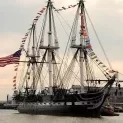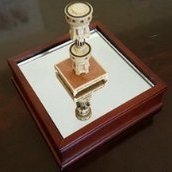-
Posts
545 -
Joined
-
Last visited
Reputation Activity
-
 bhermann got a reaction from Der Alte Rentner in Bluenose 1921 by GGibson - FINISHED - Model Shipways - 1:64
bhermann got a reaction from Der Alte Rentner in Bluenose 1921 by GGibson - FINISHED - Model Shipways - 1:64
That's an interesting thought. I suppose it's possible, but I think it would make adding the sails more challenging. Great, one more thing to mull over - this should hold me up another two years
Bob
-
 bhermann got a reaction from GGibson in Bluenose 1921 by GGibson - FINISHED - Model Shipways - 1:64
bhermann got a reaction from GGibson in Bluenose 1921 by GGibson - FINISHED - Model Shipways - 1:64
That's an interesting thought. I suppose it's possible, but I think it would make adding the sails more challenging. Great, one more thing to mull over - this should hold me up another two years
Bob
-
 bhermann reacted to Der Alte Rentner in Bluenose 1921 by GGibson - FINISHED - Model Shipways - 1:64
bhermann reacted to Der Alte Rentner in Bluenose 1921 by GGibson - FINISHED - Model Shipways - 1:64
After seeing this post to Gregg, I took a look at your Bluenose build. Sorry to see that it's been collecting dust for so long. Here's hoping you get back to the ship yard sooner rather than later. This may be a stupid question, but can't you finish it without sails, then change tack later if you feel you must add them?
-
 bhermann reacted to GGibson in Bluenose 1921 by GGibson - FINISHED - Model Shipways - 1:64
bhermann reacted to GGibson in Bluenose 1921 by GGibson - FINISHED - Model Shipways - 1:64
I have a supply of both the light and medium texture silkspan tissue from Sig Manufacturing. SIG SILKSPAN TISSUE - Sig Manufacturing (sigmfg.com)
-
 bhermann reacted to John Ruy in Bluenose 1921 by GGibson - FINISHED - Model Shipways - 1:64
bhermann reacted to John Ruy in Bluenose 1921 by GGibson - FINISHED - Model Shipways - 1:64
Greg, Thanks for the compliment on my Bluenose Sails. My personal preference has always been to build my ships with a full compliment of Sails. IMHO that’s how a sailing ship model should look. That said, I have built without sails and enjoyed the finished product. The choice is really yours to make.
@bhermann Bob the choice between cloth and silk span is really about scale. For my Bluenose I used the thinnest muslin material I could find at Joann’s Fabrics. Most kit supplied cloth is too heavy to look to scale.
Carry on Greg, you are doing a great job.
John
-
 bhermann reacted to GGibson in Bluenose 1921 by GGibson - FINISHED - Model Shipways - 1:64
bhermann reacted to GGibson in Bluenose 1921 by GGibson - FINISHED - Model Shipways - 1:64
Thanks, Bob! Appreciate the kind words! If we both need inspiration on which way to go, we need look no further than @John Ruy's recently completed Bluenose. He did some awesome sail work to finish his ship! 🏆
-
 bhermann got a reaction from GGibson in Bluenose 1921 by GGibson - FINISHED - Model Shipways - 1:64
bhermann got a reaction from GGibson in Bluenose 1921 by GGibson - FINISHED - Model Shipways - 1:64
That is some very nice work, Gregg! I can't wait to hear what you decide on the sails. My own debate on that has kept my Bluenose in limbo going on 11 years now. Sails? No sails? Cloth sails? Silkspan sails? Maybe your decision will inspire me at last!
Bob
-
 bhermann got a reaction from mtbediz in Bluenose 1921 by GGibson - FINISHED - Model Shipways - 1:64
bhermann got a reaction from mtbediz in Bluenose 1921 by GGibson - FINISHED - Model Shipways - 1:64
That is some very nice work, Gregg! I can't wait to hear what you decide on the sails. My own debate on that has kept my Bluenose in limbo going on 11 years now. Sails? No sails? Cloth sails? Silkspan sails? Maybe your decision will inspire me at last!
Bob
-
 bhermann reacted to GGibson in Bluenose 1921 by GGibson - FINISHED - Model Shipways - 1:64
bhermann reacted to GGibson in Bluenose 1921 by GGibson - FINISHED - Model Shipways - 1:64
Wow! It's been almost a full two months since I've posted any kind of build log update. I've been in the shipyard here and there over that time, in between a few trips, having all the grandkids for a week's activities here, watching the oldest granddaughter prepare for and then head to her first year away from her home at college some 8-9 states away, and just some general summertime tinkering around the house. Anyways, thought I'd get a small update in. And I took only a few pictures and hardly any detailed notes on these last activities.
After getting the lower shrouds placed, it was time to tie in what seemed like a thousand ratlines! Like everyone else does when placing ratlines, I made a lined template in order to have some relatively consistent spacing. I also used some 0.81 brass rods, blackened them, and placed the sheer poles at the base of each set of shrouds. Once you get into a routine of tying clove hitches, it goes pretty well. I would do about 4-5 rows at a time, then hit the knots with a spot of glue and once dried, clip the excess 0.009" line from each end. Then another 4-5 rows, etc., etc., etc...
As I said earlier, did not take many notes as I was preparing and installing a lot of the standing rigging, but I will go through what was done fairly quickly. There are several MSW Bluenose build logs that have great detail on their rigging procedures. I relied on them heavily and encourage others to do the same.
Spring Stay - Runs from the main mast's spring stay bail to the fore mast's spring stay bail. I used 0.027" black line.
Jib Stay - Runs from the fore mast cap to the bowsprit. I used 0.019" black line.
Jumbo Jib Stay - Runs from the fore mast to the jumbo jib stay bail. I wish I would have realized way back when I first inserted the bowsprit that this jumbo jib stay bail would be wrapped and secured around the bowsprit. At this point, it was way too difficult for me to come up with anything like that, so I "settled" for shaping a 0.81" brass rod piece so it fit around the top of the bowsprit and was secured into the deck underneath. It's the best adaptation I could come up with. I used 0.027" black line.
At this point, it was time to drop the top masts into their places. They still fit snuggly, and with the iron fids in place, it did not seem like the masts needed any additional glue.
Main Top Mast Shrouds and Fore Mast Spreader Lifts - The main top mast shrouds run from the top of the mast down to lanyards that then connected to the spreaders. The fore mast spreader lifts run from a band about a third of the way up the top mast down to lanyards that are connected to the fore mast spreader. I used 0.019" black line for the shrouds and 0.009" light beige line for the lanyards. I then tied ratlines to each of the shrouds and spreader lifts, but only did about a dozen ratlines on the main mast shrouds, reaching about a third of the way up the top mast on each side, using 0.009" black line again for the ratlines.
Pullback Stay - Runs from the top of the fore mast to the main mast cap. Still having a bit of difficulty shaping a shackle like how John Ruy explained he did his, so I simply used a small jump ring to connect to the bowsprit. I used 0.019" black line.
Balloon Jib Stay - Runs from the top of the fore mast to the end of the bowsprit. I used 0.027" black line.
Main Mast Top Stay - Runs from top of main mast to fore mast cap. I used 0.019" line.
Flying Backstays - Two sets of backstays run from the top of the main mast to either side of the stern transom. The main runs start from the main top mast using 0.027" black line. They run down to a 5/32" double block. This block is then laced with a 5/32" single block using 0.013" light beige line. The single block is connected with a "S" hook to a 0.013" black line tied to an eyebolt on the transom. The beige line then falls to a belaying pin on the rail. I have not permanently secured the top of these backstays to the main top mast or the fall line to the belay pins at this time, as I fear they would get snagged and be in the way when I work on the remainder of the running rigging and the main boom. So, the lines will come down from the main top mast as I do that work.
I am going to see if I can get some running lights placed on the two sets of foremast shrouds. Then it is time to get the running rigging that I prepped months ago attached where it belongs on this Bluenose! Those of you who have followed my progress (or lack thereof) on this Bluenose (thank you, by the way!) may recall that I have wrestled with how to finish my Bluenose... with sails, without sails, or furled sails. And I have leaned each of the three ways multiple times over the almost-two years I have worked on her. Well, stand by for my decision...!
Thanks to all for taking the time to read, comment and criticize! Appreciate all of the support, whether it's been your input here or my peeking in on your own Bluenose build logs and having one of those "Oh, yeah!" epiphanies. Thanks!
-
 bhermann got a reaction from Nirvana in Bluenose by Nirvana - Model Shipways - Scale 1:64
bhermann got a reaction from Nirvana in Bluenose by Nirvana - Model Shipways - Scale 1:64
Per - do you really Moon us??? Nice image. On the bars, did you consider trying to file slots in the underside of the frame? I know they would be tiny, but if it could be done, that might provide a little more purchase to hold the bars in place.
BTW, I am no expert on the skylight windows - all I did was paint some black squares on the solid white box to simulate windows, pretty cheesy.
Bob
-
 bhermann got a reaction from Nirvana in Bluenose by Nirvana - Model Shipways - Scale 1:64
bhermann got a reaction from Nirvana in Bluenose by Nirvana - Model Shipways - Scale 1:64
Per, if I may. I suspect John is referring to the tops of the bulkheads that become some of the deck stanchions. My recollection is that the kit-provided bulkheads were thicker than the stanchion dimension, and that is the reason for thinning the top of the bulkhead above where the decking is laid, to make those tops the same thickness as the stanchions.
For my build (many years back) I simply cut off all the bulkhead extensions and installed new stanchions above the deck from end to end.
If I'm wrong, John will post a reference to the post he is talking about, and we'll move on from there
Bob
-
 bhermann got a reaction from Nirvana in Bluenose by Nirvana - Model Shipways - Scale 1:64
bhermann got a reaction from Nirvana in Bluenose by Nirvana - Model Shipways - Scale 1:64
Good to see you at it again, Per. You are coming along nicely.
Bob
-
 bhermann reacted to John Ruy in 1921 Bluenose by John Ruy - FINISHED - Model Shipways - 1/64 scale - Canadian Fishing Schooner
bhermann reacted to John Ruy in 1921 Bluenose by John Ruy - FINISHED - Model Shipways - 1/64 scale - Canadian Fishing Schooner
On display in my Gallery. 😎
Cheers 🍻
-
 bhermann reacted to John Ruy in 1921 Bluenose by John Ruy - FINISHED - Model Shipways - 1/64 scale - Canadian Fishing Schooner
bhermann reacted to John Ruy in 1921 Bluenose by John Ruy - FINISHED - Model Shipways - 1/64 scale - Canadian Fishing Schooner
Flags and Flag Halyards…
Main Flag Halyard belayed to Cleat on the Main Boom. (Canadian 1921 Flag)
Main Top Mast Flag Halyard belayed to Sheer Pole. (Nova Scotia 1921 Flag)
FINISHED! 🍻
-
 bhermann reacted to John Ruy in 1921 Bluenose by John Ruy - FINISHED - Model Shipways - 1/64 scale - Canadian Fishing Schooner
bhermann reacted to John Ruy in 1921 Bluenose by John Ruy - FINISHED - Model Shipways - 1/64 scale - Canadian Fishing Schooner
Main Topsail…
Bolt Rope, Halyard, Tack and Sheet lines attached.
Clew Line attached with fair leads and blocks.
Mast Hoops attached…
Laid her on her side to spray Fabric Stiffener on the Main Topsail.
Clew belayed to pin# 33 Port..
Main Topsail Halyard belayed to Pin# 37 Port.
Main Topsail Tack belayed to Pin# 24 Starboard.
Main Topsail Sheet belayed to Pin# 32 Port.
One more application of Fabric Stiffener using a hair dryer to stiffen the wind into place. 😎
Almost done… Here’s my final punch list.
1. Baggy Wrinkles
2. 1921 Canadian Flag w/halyard on Main Gaff
3. 1921 Nova Scotia Flag w/halyard on Main Top Mast
The drawings show a Flag Halyard on the Fore Top Mast. I’m not sure what goes there. Any ideas?
Is there anything I have missed?
Cheers 🍻
-
 bhermann reacted to John Ruy in 1921 Bluenose by John Ruy - FINISHED - Model Shipways - 1/64 scale - Canadian Fishing Schooner
bhermann reacted to John Ruy in 1921 Bluenose by John Ruy - FINISHED - Model Shipways - 1/64 scale - Canadian Fishing Schooner
Main Sail…
Main Sheet Bolt Rope and Reef Lines completed.
Lacing of the Main Sheet to the Boom and Gaff completed.
Boom Tackle completed and belayed to Pin #27 Port.
Topping Lift Tackle completed and belayed to pin# 26 starboard.
Quarter Lifts Pendants completed Port and Starboard.
Completed Foot Ropes Port and Starboard.
Peak Halyard Bridles completed with Blocks.
Boom and Gaff attached to the Main Mast and Main Sail Hoops Attached to Main Sail.
Peak Halyard Rigged.
She has wind in her Main Sail.
Main Sheet Tackle belayed to Bitt on Starboard side.
Quarter Lift and Lazy Jack Line installed.
Quarter Lift, Peak and Throat Halyard Tackles installed and belayed.
Onwards to the last Sail, the Main Top Sail. Steady as she goes. 🍻
-
 bhermann reacted to GGibson in Bluenose 1921 by GGibson - FINISHED - Model Shipways - 1:64
bhermann reacted to GGibson in Bluenose 1921 by GGibson - FINISHED - Model Shipways - 1:64
Another small update as I complete different phases of the rigging process (and I haven't even gotten to the fun stuff yet!)... A few weeks ago, I had run the shrouds for the lower masts and had begun to attach the lanyards to each of the sixteen sets of deadeyes. I was pleased in how that all came out, with all of the deadeyes appearing to be spaced well and even with one another. I'll work on the ratlines very soon.
With the lower shrouds rigged (short of the ratlines), I then completed the lines for the spring stay, the jib stay and the jumbo jib stay. All pretty much straight-forward runs. I wish I knew how to create nice shackles, as I simply used some brass jump rings in place of shackles where they were called for. Perhaps by the time I get to the builds waiting in the wings, I'll come up with a good method/process. I realized I had not previously prepared and installed the jumbo jib stay bail that wraps around the bowsprit, so I roughly tried to shape one using 1mm brass rod and inserted each end into the deck.
I also noted as I was working on running the line for the spring stay between the main mast and fore mast that I had not placed the futtock shrouds (two on each side (port and starboard) that are brass wire pieces starting as eyebolts on the trestle tree spreaders and are bent to the hoops in the futtock band. Inserted those and secured with a drop or two of CA glue.
Well, I think other than working on the aforementioned lower shroud ratlines, my next step may be the top masts, and everything associated with securing those. Hope I haven't forgotten anything else that may be more difficult as the rigging process continues!
As always, appreciate everyone's time in reading, liking (or laughing), and comments. For those in the USA celebrating the Independence Day festivities this week, please have a safe and awesome celebration with friends and families! God Bless the USA!
-
 bhermann reacted to Caferacer in Benjamin W Latham by Caferacer - FINISHED - Model Shipways
bhermann reacted to Caferacer in Benjamin W Latham by Caferacer - FINISHED - Model Shipways
Details keep coming, just when you think you're done. It took me a while to figure these catheads out, but here we are.
The drawings were confusing me until I realized the swing out. I'll be leaving them in the "parked" position as the anchors will be stowed.
I didn't have wire small enough to create rings for the chains, so I seized them with some thread. I mocked it up with the line, arranged about how it would be on the model and painted it.
The windlass drove me a little crazy to be honest. I couldn't seem to resolve all the dimensions between the bowsprit, windlass position and the other parts. The windlass would have fouled on the top rail if it were farther forward, or the Samson post needed to be farther back. I'm only guessing but I think it's tolerance stack up between all these parts and the contour of the top rail/hull.
-
 bhermann reacted to GGibson in Bluenose 1921 by GGibson - FINISHED - Model Shipways - 1:64
bhermann reacted to GGibson in Bluenose 1921 by GGibson - FINISHED - Model Shipways - 1:64
Another very small update since it's been over a month. Had some travels to attend the oldest granddaughter's HS graduation and a few other distractions, as well as just taking some time on this area of the Bluenose build.
Time to work on the lower mast shrouds. Cut out the kit-supplied oval deadeyes from the sheet, cleaned them up the best I could (these things are small!), strung them on some thread, dipped them in some stain, and hung them to dry.
Using some .5mm (0.019") black rope for the shrouds, I tied and seized the eight lengths at the tops of the lower shrouds and, as others have done, created a "spacer jig" with some wire in order to manage the consistent length of each shroud and deadeye. Getting some small grooves around the oval deadeyes was helpful in securing the rope to the deadeyes before hitting them with some diluted PVA and seizing with smaller thread.
Have now just begun to run the lanyards between the oval deadeyes and their respective round deadeyes. I am using .35mm (0.013") tan rope for the lanyards. Two lanyards down, fourteen to go. Can't wait until I get to the ratlines...!! 🤣🤣
And, in the "for what it's worth" category, I hate these extreme closeup photos that detail how bad some of this paint job is... Grrr.....
As always, appreciate the comments and criticisms.
-
 bhermann got a reaction from John Ruy in 1921 Bluenose by John Ruy - FINISHED - Model Shipways - 1/64 scale - Canadian Fishing Schooner
bhermann got a reaction from John Ruy in 1921 Bluenose by John Ruy - FINISHED - Model Shipways - 1/64 scale - Canadian Fishing Schooner
That is a superb job of attaching the sails and making them look lifelike! You are really raising the bar with your fine work.
Bob
-
 bhermann reacted to John Ruy in 1921 Bluenose by John Ruy - FINISHED - Model Shipways - 1/64 scale - Canadian Fishing Schooner
bhermann reacted to John Ruy in 1921 Bluenose by John Ruy - FINISHED - Model Shipways - 1/64 scale - Canadian Fishing Schooner
Fore Topsail…
Fore Topsail Halyard Blocks…
Blocks and Fairleads for Clew…
Tack…
Sheet…
Installing Sheet Blocks…
Topsail Hoisted
Halyard belayed to pin #15 port…
Setting Rope Coil for Topsail Halyard…
Topsail Halyard Rigged…
Topsail Tack belayed to pin #10 starboard Fore Pinrail.
Fore Topsail Sheet belayed to pin #20 starboard.
Port Sheet and Tack must hang slack over Standing Rigging.
Belayed to Port Pin # 9 and 19
Time to lay her on her side and put some wind in her sails. 😎 Fabric Stiffener does the trick.
Ready for the Main Sail and its Topsail.
Cheers 🍻
-
 bhermann reacted to John Ruy in 1921 Bluenose by John Ruy - FINISHED - Model Shipways - 1/64 scale - Canadian Fishing Schooner
bhermann reacted to John Ruy in 1921 Bluenose by John Ruy - FINISHED - Model Shipways - 1/64 scale - Canadian Fishing Schooner
Fore Sail…
Added Bolt Rope and Reef Points to previously sewn Fore Sail.
Installed block and line for Top Sail Sheet.
Laced Gaff to Fore Sail.
Laced Fore Sail to Boom.
Added Parrel w/Wood Trucks to Gaff.
Blocks for the Fore Sail Rigging.
Throat Halyard attached to Gaff.
Connecting Gaff to Fore Mast.
Throat Halyard in place.
Peak Halyards in place.
Sewing Mast Hoops to the Sail.
Fore Mast Hoops attached to Fore Sail.
Boom Tackle placed.
Placing Fore Sail Sheet.
Sheet belayed to Fife Rail.
Topping Lift installed.
Topping Lift belayed to Fife Rail.
Peak Halyard belayed to pin #8.
Eyelet for Throat Halyard Block inaccessible.
Had to remove Engine Box. Fortunately, spot glued with CA and I was able to pop it out.
Throat Halyard belayed to pin #7.
Peak Halyard Tackle belayed to pin #17.
Throat Halyard belayed to pin # 18.
Fore Sail Downhaul belayed to Fore Boom.
Fore Sail Rigging complete.
Cheers. 🍻
-
 bhermann reacted to gjdale in African Queen by gjdale (Grant) - Billing Boats (modified) - Scale 1:12 - RADIO - Live Steam
bhermann reacted to gjdale in African Queen by gjdale (Grant) - Billing Boats (modified) - Scale 1:12 - RADIO - Live Steam
It’s been a little while since the last progress update, but work has continued apace. The first job was to finalise the placement of the steam plant and build a mounting for it, along with a support block for the stern stuffing tube. I used a piece of 7mm thick Queensland Maple for the support base and another to create the support block for the stuffing tube. As the plant is held to its own metal base by screws inserted from underneath, it was necessary to make allowance for the screw heads. With that temporarily in place, the engine drive shaft and the propellor could be aligned, allowing the support block for the stuffing tube to me made and fitted. Once these had both been double checked for fit and alignment, they were fixed in place and the internal surfaces painted using my large airbrush / mini spray gun and Stynylrez White Primer – despite it being a primer, this will be the final colour for the internals.
In the next photo, you can see that two M3 threaded inserts have been incorporated into the aft end of the mounting plate. These align with two corresponding holes in the metal base plate to secure the plant in the boat.
Here is an overhead shot showing the steam plant in place along with the complete propellor shaft. Also shown in this photo is the large brass flywheel that my friend made for me, as well as the universal joint (the red piece in the photo).
The next task was to begin addressing the decking. Having adjusted the plywood sheet as previously described, I decided to stain the plywood to act as the margin plank while additional planking was added for the deck. Here is the plywood after staining.
To create the decking, I have used a combination of 12mm x 1mm Brown Hornbeam and 1mm x 1mm Black Hornbeam to simulate the caulking. The first task was to create the centreline plank by sandwiching a piece of the Black caulking between two Brown planks.
The remaining planking was created by gluing one piece of Brown plank to one piece of Black caulking. Once dry, the resultant pair was scraped to remove any excess glue. Rinse and repeat for all remaining planks. Here is what they look like when put together.
Once all the plank pairs had been prepared, they were applied to the decks starting with the centreline sandwich and working outwards from there. The planks were shaped to fit the outline of the margin plank as I went. Here are some shots of the planking in place – not yet given a coat of finish (which should make it pop a little), and not yet glued down.
Finally, an overview shot of progress to date. Note that the upper deck is not yet glued down – it will sit down on the gunwale around the centre once glued.
I think the next task will be to paint the external of the hull before proceeding to permanently fix the decks. I will also need to address the small matter of Radio Control in the not-too-distant future. I have a cunning plan………..
-
 bhermann reacted to GGibson in Bluenose 1921 by GGibson - FINISHED - Model Shipways - 1:64
bhermann reacted to GGibson in Bluenose 1921 by GGibson - FINISHED - Model Shipways - 1:64
Well, after last week's start with the pre-rigging on stuff coming off the main mast, I continued around the ship and tried to catch every bit of rigging that I could do now, off the ship, for each of the five (5) booms and gaffs. I've doubled my seven pre-riggings to fourteen (14) and have labeled them (hopefully accurately enough to know where they go!). The ones on the top row are what I completed since last week.
Unless I am forgetting another important step in the pre-rigging process, it appears my next task is to get the masts placed so that I can begin on the lower shrouds. But... before that, I think it is also time to get the Bluenose on its display base/pedestals, and also get the dories and kids firmly placed, as I've been holding off on their placement for fear of snagging them.
Might also get the silkspan out that I recently ordered for the sails to see how easily it will be to work with.
Appreciate all the advice, likes and comments.
-
 bhermann reacted to John Ruy in 1921 Bluenose by John Ruy - FINISHED - Model Shipways - 1/64 scale - Canadian Fishing Schooner
bhermann reacted to John Ruy in 1921 Bluenose by John Ruy - FINISHED - Model Shipways - 1/64 scale - Canadian Fishing Schooner
Jib Downhauls…
Just in, Amati Rope for the downhaul rigging.
Threading down haul through hanks.
Tying down haul off to Jumbo Jib.
Jumbo Jib down haul belayed to starboard bitt.
Jib Downhaul belayed to pin #2
Balloon Jib belayed to pin #1.
Jib Downhauls complete with rope coils.
Cheers 🍻







